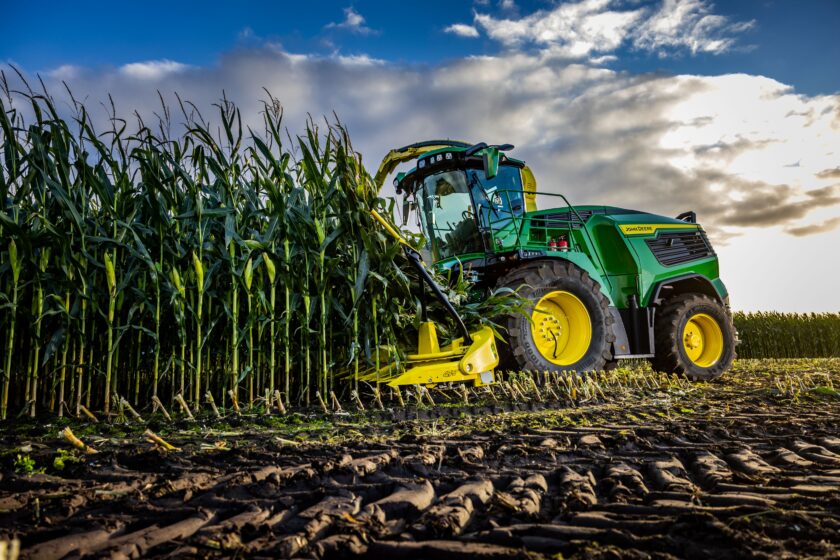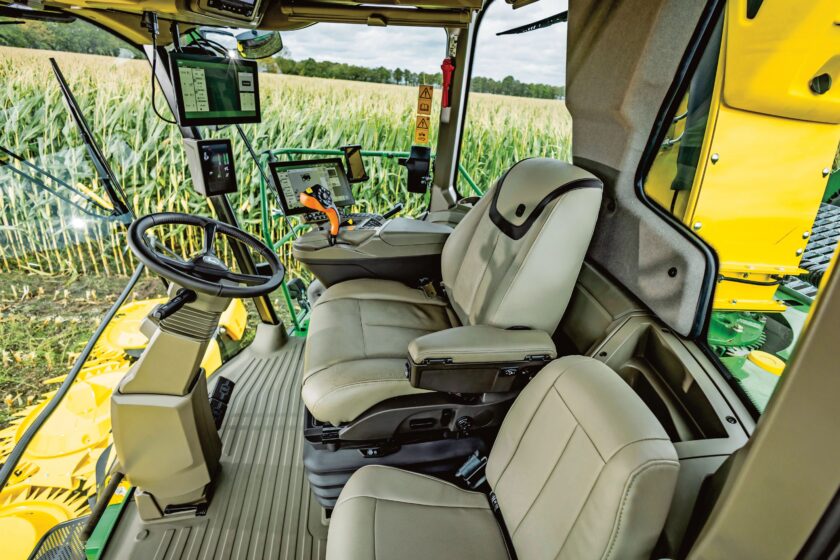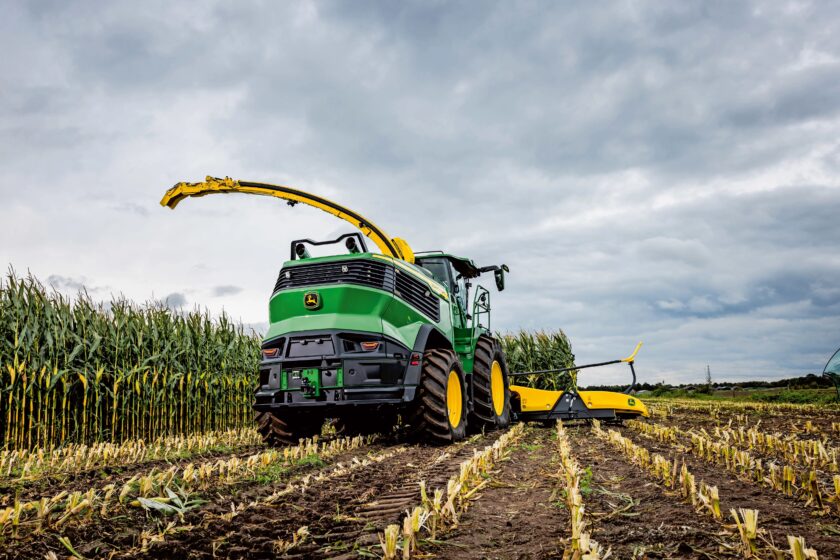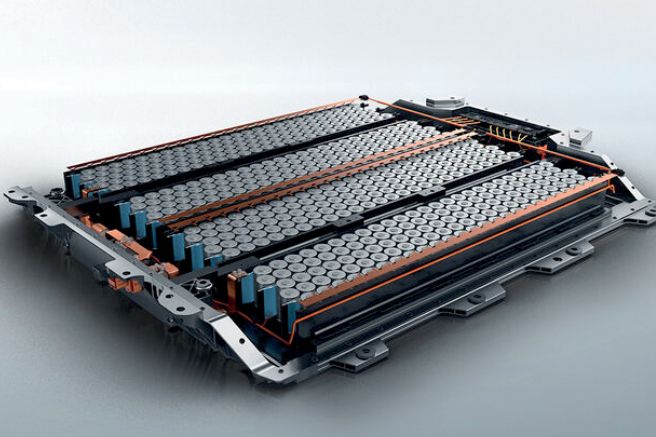John Deere is completely overhauling its self-propelled forage harvesters, updating their features and boosting their performance offering. The new machine lines, designated “F8” and “F9,” will gradually replace the current “8000” and “9000” series

John Deere made its debut in the self-propelled forage harvester sector in 1972 with the launch of the “5200” and “5400” series models, offering power outputs of 178 and 255 horsepower respectively.
This was followed by the “6000” series in 1992, the “7000” series in 2003, and finally the “8000” and “9000” series between 2015 and 2019, which pushed installed power up to a maximum of 970 horsepower. That’s more than 50 years of industry experience, bolstered by John Deere’s century-long expertise in engine design, resulting in machines that consistently deliver top-tier performance, high reliability standards, and the latest in technological innovation.
This legacy continues with the launch of the new “F8” and “F9” series machines, which are set to gradually replace the current “8000” and “9000” lines. These new harvesters offer broader power ranges, enhanced comfort, and new automation solutions. The “F8” series will include six models. With power outputs ranging from 425 to 645 horsepower — both lower and higher than the current “8000” series’ range of 465–625 horsepower.

The top-tier “F9” machines will also expand their range, starting at 700 horsepower (compared to the 765 hp base of the current “9000” series) and going all the way up to 1,020 horsepower. This makes the “F9 1000” model the most powerful agricultural machine ever offered by John Deere.
This performance is delivered by a 24-liter “D9512” V12 engine from Liebherr, also used in the “F9 900.” However, starting with the “F9 700” model, all machines are powered by original JD Power engines. The “F9 700,” “F9 600,” and “F9 500” models feature an 18-liter JD 18X six-cylinder engine. The entire “F8” series is powered by the JD 14X six-cylinder engine, displacing 13.6 liters.

All machines comply with Stage V emissions standards, thanks to integrated intake and exhaust treatment systems. These include fixed or variable geometry turbochargers — depending on the model — always supported by air-to-air intercoolers. Every engine is part of a highly automated powertrain system that works in tandem with the harvesting system, enabling new functions designed to reduce operator effort and fatigue.
One standout feature is the automated ground speed control, which adjusts the harvester’s speed and engine RPM based on load conditions. Regardless of operating environment, the machine always works at maximum productivity and efficiency. An active trailer filling control system automatically detects trailers and adjusts the spout’s rotation and position using stereo cameras to ensure optimal filling.

The “ProTouch Harvest” system automates headland turns, managing header lift, spout control, and the above-mentioned features, all integrated into John Deere’s “AutoTrac” system. When transitioning from road to field, the “ProTouch” technology manages up to nine functions, including signal lights, all-wheel drive, engine speed settings, and spout positioning.
Additional precision farming technologies can be added based on the individual needs of each farm, while intuitive controls ensure easy management of machine and harvest settings.
Onboard “G5 CommandCenter” or “G5Plus CommandCenter” systems come standard and automate all operational aspects — from folding the cutter bar to opening the spout, engaging/disengaging all-wheel drive, and activating features like “AutoTrac,” “ProTouch,” and “Machine Sync.”
A new “CommandPro” joystick with 11 programmable buttons allows the operator to control the entire machine with one hand. If needed — all while keeping an eye on live data about machine status, which can also be transmitted in real time to the farm’s technical office through John Deere’s connectivity platform.
Cabins Completely Redesigned
Among the most significant innovations on John Deere’s new “F8” and “F9” forage harvesters are their entirely redesigned cabins. The future-ready to equip the brand’s combines as well. These cabs offer comfort and digitalization features that often exceed industry standards. One standout example is the electrically operated door, a unique feature in agricultural machinery.
The cabin space has been fully optimized to provide convenient storage for every item, with dedicated supports for smartphones, keys, and beverages. The “Premium Infotainment” system includes Bluetooth connectivity for the driver’s smartphone, as well as full integration with Apple CarPlay and Android Auto. Multiple charging options are available for personal devices, and the seat — the “ActiveSeat” — can swivel 16 degrees left or right for easier access and improved visibility.
Upgrading to the “ActiveSeat II” version adds electric controls, heated and cooled seating, a massage function, and active suspension that isolates up to 90% of vertical movements. All this is paired with a new rear axle steering system enabling a turning radius of just six meters.
Special Focus on Kernel Processors

The new “F8” and “F9” self-propelled forage harvesters build upon the crop handling systems of the previous generation, with updates aimed at optimizing silage quality. The “F8” models feature 660 mm-wide crop channels, while the “F9” models extend this to 830 mm.
They are equipped with “DuraDrum” rotors, which can be configured with different blade arrangements depending on operational needs. The new “IDS 2.0” metering systems now incorporate “HarvestLab” sensors; and can be fed either by a 50-liter isolated tank for concentrated additives or a 325-liter tank for high-volume applications or water.
Two new kernel processor options are also introduced: the “Ultimate 250” and “XStream 305” systems. The former uses 250 mm-diameter rollers, features a temperature monitoring system, and has a foldable structure for easier maintenance. The “XStream 305” offers 305 mm rollers, resulting in a 56% larger working surface that enables higher harvesting speeds. It also includes an electric adjustment system and an oil mist lubrication setup to ensure optimal operation across all cutting lengths.
Titolo: John Deere F8 and F9 forage harvesters: act four
Translation with ChatGPT







